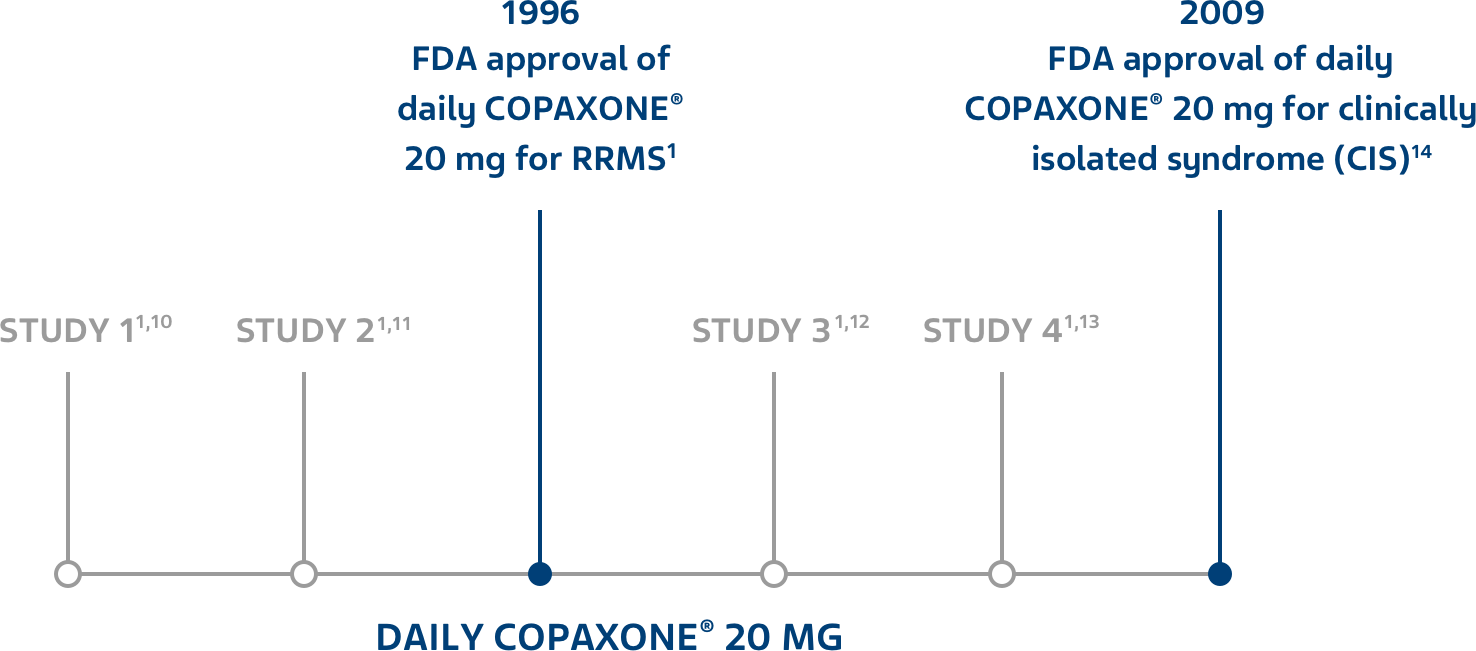HOW DOES COPAXONE® WORK?
COPAXONE® (glatiramer acetate injection) is used to treat relapsing forms of multiple sclerosis (MS). It is an injection made with glatiramer acetate, which is thought to act by modifying immune processes that are believed to be responsible for the pathogenesis of MS. Patients taking COPAXONE® may see results in 12 months.1
HOW RELAPSING MULTIPLE SCLEROSIS (RMS) AFFECTS YOUR BODY
-
RMS is most commonly known for affecting the central nervous system (CNS), which is made up of the brain, spinal cord, and optic nerves. The CNS is affected through an abnormal response of the body's immune system.2
-
The immune system is made up of a network of cells, tissues, and proteins. There are many types of cells that play a part in the body’s immune response, one of which is called a T cell. In RMS, inflammatory T cells attack the myelin that protects the nerve tissue in the CNS.2,3
COPAXONE® AND YOUR IMMUNE SYSTEM
-
COPAXONE® is thought to modify immune processes believed to be responsible for activating MS. Therapies approved to treat relapsing RMS, as well as treatments currently being studied, are thought to have an impact on the immune system. Because COPAXONE® is thought to modify the immune system, it may interfere with immune functions. There is no evidence that COPAXONE® reduces the body's normal immune response, but this has not been systematically evaluated.1,4,5
MS THERAPY AND IMMUNOSENESCENCE
-
Managing your MS is more than choosing a therapy that works today. As you age, immunosenescence (the aging of your immune system) should be considered—it can increase your risks for other serious conditions. That’s why managing your MS with a therapy that’s right for you is so important.6
Consider the results of 3-times-a-week COPAXONE® 40 mg, studied in the largest pivotal trial ever conducted for COPAXONE®.1
-
Primary study results: COPAXONE® 40 mg reduced the number of relapses compared with placebo (an inactive substance) at 12 months.
Fewer relapses compared with placebo1,7
Relapses, also called flare-ups or attacks, can cause new symptoms to occur and make old symptoms worse.8
Relapses, also called flare-ups or attacks, can cause new symptoms to occur and make old symptoms worse.6
-
Secondary study results: COPAXONE® 40 mg showed a significant reduction in the underlying disease activity as measured by brain lesions on magnetic resonance imaging (MRI) over 12 months compared with placebo.1,7
Reduction in the total number of enhancing lesions on T1-weighted images1,7
T1-enhancing lesions, also known as gadolinium-enhancing T1 lesions, show areas where brain tissue is currently inflamed.9
T1-enhancing lesions, also known as gadolinium-enhancing T1 lesions, show areas where brain tissue is currently inflamed.9
Reduction in the total number of new and enlarging T2 lesions1,7
T2 lesions show areas where the brain tissue has been damaged.9
T2 lesions show areas where the brain tissue has been damaged.9
COPAXONE® STUDIED ACROSS 5 CLINICAL TRIALS1


A 27-year study of the active ingredient in COPAXONE® found long-term safety results16
Some participants from the clinical trial of COPAXONE® opted into a long-term, open-label extension (OLE) study, which means that all participants were aware of the drug being tested. The OLE study looked at the safety and efficacy of the drug over time.
All participants were randomized and categorized as follows:
-
Entered the OLE:
-
208 out of 251 (82.9%)
-
Completed the OLE:
-
24 out of 101 (23.8%, Early Start)
-
28 out of 107 (26.2%, Delayed Start up to 3 years)
Sustained results in treating RMS were found with earlier initiation of glatiramer acetate. Safety and efficacy were both necessary for FDA approval and Teva has continued to prioritize these for over 25 years.16
Up to year 25Full study period
% of participants with stable/improved EDSS
Early start (ES)
Delayed start (DS)
KEY: EDSS: Expanded Disability Status Scale
The Expanded Disability Status Scale (EDSS) is a way of measuring how much someone is affected by their MS. You might hear your neurologist talk about it or see it mentioned in reports on trials of MS drugs.17
For more about how COPAXONE® treats MS, visit our educational resources.
References:
-
COPAXONE® (glatiramer acetate injection) Current Prescribing Information Parsippany, NJ. Teva Neuroscience, Inc.
-
Definition of MS. National Multiple Sclerosis Society (NMSS). Accessed November 18, 2018. https://www.nationalmssociety.org/What-is-MS/Definition-ofMS
-
What is an immune-mediated disease? National Multiple Sclerosis Society (NMSS). Accessed November 18, 2018. https://www.nationalmssociety.org/What-is-MS/Definition-of-MS/Immune-mediated-disease
-
Bennett JL, Stüve 0. Update on inflammation, neurodegeneration, and immunoregulation in multiple sclerosis: therapeutic implications. Clin Neuropharmacol. 2009;32(3):121-132. doi:10.1097/WNF.0b013e3181880359
-
Balashov K. Drugs in development for multiple sclerosis. Practical Neurology. February 2020. Accessed July 13, 2021. https://practicalneurology.com/articles/2020-feb/drugs-in-development-for-multiple-sclerosis
-
Goronzy JJ, Weyand CM. Understanding immune senescence to improve vaccine responses. Nat Immunol. 2013;14(5):428-436. doi:10.1038/ni.2588
-
Khan O, Rieckmann P, Boyko A, Selmaj K, Zivadinov R; for the GALA Study Group. Three times weekly glatiramer acetate in relapsing-remitting multiple sclerosis. Ann Neurol. 2013;73(6):705-713. doi.10.1002/ana.23938
-
Managing relapses. National Multiple Sclerosis Society (NMSS). Accessed November 18, 2018. https://www.nationalmssociety.org/Treating-MS/Managing-Relapses
-
Magnetic resonance imaging (MRI). National Multiple Sclerosis Society (NMSS). Accessed November 18, 2018. https://www.nationalmssociety.org/Symptoms-Diagnosis/Diagnosing-Tools/MRI
-
Bornstein MB, Miller A, Slagle S, et al. A pilot trial of Cop 1 in exacerbating-remitting multiple sclerosis. N Engl J Med. 1987;317(7):408-414. doi:10.1056/NEJM198708133170703
-
Johnson KP, Brooks BR, Cohen JA, et al; the Copolymer 1 Multiple Sclerosis Study Group. Copolymer 1 reduces relapse rate and improves disability in relapsing-remitting multiple sclerosis: results of a phase III multicenter, double-blind, placebo-controlled trial. Neurology. 1995;45(7): 1268-1276. doi:10.1212/wnl.45.71268
-
Comi G, Filippi M, Wolinsky JS; and the European/Canadian Glatiramer Acetate Study Group. European/Canadian multicenter, double-blind, randomized, placebo-controlled study of the effects of glatiramer acetate on magnetic resonance imaging-measured disease activity and burden in patients with relapsing multiple sclerosis. Ann Neurol. 2001;49(3):290-297. https://doi.org/10.1002.ana.64
-
Comi G, Martinelli V, Rodegher M, et al; PreCISe Study Group. Effect of glatiramer acetate on conversion to clinically definite multiple sclerosis in patients with clinically isolated syndrome (PreCISe study): a randomised, double-blind, placebo-controlled trial. Lancet. 2009;374(9700):1503-1511. doi.10.1016/50140-6736(09)61259-9
-
US Department of Health and Human Services. Supplement approval. Accessed November 18, 2018. https://www.accessdata.fda.gov/drugsatfda_docs/appletter/2009/020622s057ltr.pdf
-
US Department of Health and Human Services. Supplement approval. Accessed November 18, 2018. https://www.accessdata.fda.gov/drugsatfda_docs/appletter/2014/020622Orig1s089ltr.pdf
-
Ford CC, Cohen JA, Goodman AD, et al. Early versus delayed treatment with glatiramer acetate: Analysis of up to 27 years of continuous follow-up in a US open-label extension study. Mult Scler. 2022;28(11):1729-1743. doi:10.1177/13524585221094239
-
Expanded Disability Status Scale (EDSS). Multiple Sclerosis Society (MS Society UK). Accessed August 9, 2023. https://www.mssociety.org.uk/about-ms/treatments-and-therapies/getting-treatment-for-ms/expanded-disability-status-scale
You are about to leave COPAXONE.com and enter a website operated by a third party.
Would you like to continue?
The information on this site is intended for healthcare professionals in the United States. Are you a healthcare professional in the United States?



